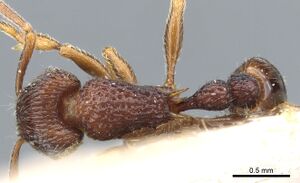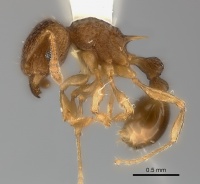Tetramorium ornatum
| Tetramorium ornatum | |
|---|---|

| |
| Scientific classification | |
| Kingdom: | Animalia |
| Phylum: | Arthropoda |
| Class: | Insecta |
| Order: | Hymenoptera |
| Family: | Formicidae |
| Subfamily: | Myrmicinae |
| Tribe: | Crematogastrini |
| Genus: | Tetramorium |
| Species: | T. ornatum |
| Binomial name | |
| Tetramorium ornatum Emery, 1897 | |
| Synonyms | |
| |
Known from mesic forest habitats where it has been found in litter samples.
Identification
Bolton (1977) - This is the most widespread species of the group, occurring in the Bismarck Archipelago and in Queensland (where a closely related species, Tetramorium australe, is also present) as well as being relatively common in parts of New Guinea. The closest relative of ornatum in New Guinea is the somewhat larger Tetramorium sculptatum, in which the frontal carinae are even more reduced and in which the antennal scrobes are completely lacking.
Keys including this Species
Distribution
Latitudinal Distribution Pattern
Latitudinal Range: -1.966167° to -37°.
| North Temperate |
North Subtropical |
Tropical | South Subtropical |
South Temperate |
- Source: AntMaps
Distribution based on Regional Taxon Lists
Australasian Region: Australia.
Indo-Australian Region: New Guinea.
Distribution based on AntMaps
Distribution based on AntWeb specimens
Check data from AntWeb
Countries Occupied
| Number of countries occupied by this species based on AntWiki Regional Taxon Lists. In general, fewer countries occupied indicates a narrower range, while more countries indicates a more widespread species. |

|
Estimated Abundance
| Relative abundance based on number of AntMaps records per species (this species within the purple bar). Fewer records (to the left) indicates a less abundant/encountered species while more records (to the right) indicates more abundant/encountered species. |

|
Biology
Castes
Worker
Images from AntWeb
   
| |
| Syntype of Tetramorium ornatum. Worker. Specimen code casent0904855. Photographer Z. Lieberman, uploaded by California Academy of Sciences. | Owned by MSNG, Genoa, Italy. |
Nomenclature
The following information is derived from Barry Bolton's Online Catalogue of the Ants of the World.
- ornatum. Tetramorium ornatum Emery, 1897c: 585, pl. 15, fig. 27 (w.) NEW GUINEA. Senior synonym of obscurius: Bolton, 1977: 107.
- obscurius. Tetramorium ornatum var. obscurius Forel, 1901b: 11 (w.) NEW GUINEA (Bismarck Archipelago). Junior synonym of ornatum: Bolton, 1977: 107.
Unless otherwise noted the text for the remainder of this section is reported from the publication that includes the original description.
Description
Worker
Bolton (1977) - TL 3.0-3.8, HL 0.70-0.92, HW 0.60-0.84, CI 84-91, SL 0.50-0.68, SI 80-87, PW 0.46-0.62, AL 0.86-1.14 (46 measured).
Mandibles striate, anterior clypeal margin convex and entire. Frontal carinae feeble, usually no more strongly developed than the longitudinal sculpture of the head, but extending back beyond the level of the eyes, sometimes almost reaching the occipital margin but here virtually indistinguishable from the other sculpture. Antennal scrobes present but exceedingly feeble. Maximum diameter of eye c. 0.12-0.16. Propodeal spines usually weakly downcurved along their length but sometimes almost straight or very weakly sinuate, variation being present in single nest-series. Metapleural lobes elongate-triangular and acute. Petiole in profile with a long peduncle and a long, low node, the dorsal length of which is about equal to or slightly greater than the height of the tergal portion. Clypeus with five distinct longitudinal carinae of about equal strength, sometimes with another intercalary pair present which are usually weaker or incomplete. Dorsum of head strongly sculptured with regular, more or less parallel longitudinal rugae or carinae, without cross-meshes. These rugae are closely packed, with usually 12-15 between the frontal carinae at the level of the eyes (a few specimens are known with 10-11). Dorsal alitrunk with a coarse rugoreticulum which extends down the sides of the pronotum. Sides of nodes of petiole and postpetiole rugose but on the postpetiole dorsum this is usually weaker. Gaster unsculptured. All dorsal surfaces of head and body with numerous fine hairs, those on the dorsal (outer) surface of the hind tibiae short and curved. Colour varying from reddish brown to blackish brown.
Type Material
- Syntype, worker(s), Aitape (as Berlinhafen), Papua New Guinea, Musee d'Histoire Naturelle Genève.
References
- Bolton, B. 1977. The ant tribe Tetramoriini (Hymenoptera: Formicidae). The genus Tetramorium Mayr in the Oriental and Indo-Australian regions, and in Australia. Bulletin of the British Museum (Natural History). Entomology. 36:67-151. (page 107, Senior synonym of obscurius)
- Emery, C. 1897c. Formicidarum species novae vel minus cognitae in collectione Musaei Nationalis Hungarici quas in Nova-Guinea, colonia germanica, collegit L. Biró. Természetr. Füz. 20: 571-599. (page 585, pl. 15, fig. 27 worker described)
References based on Global Ant Biodiversity Informatics
- Andersen A. N., J. C. Z. Woinarski, and B. Hoffman. 2004. Biogeography of the ant fauna of the Tiwi Islands, in northern Australia's moonsoonal tropics. Australian Journal of Zoology 52: 97-110.
- Andersen A. N., M. Houadria, M. Berman, and M. van der Geest. Rainforest ants of the Tiwi Islands: a remarkable centr of endemism in Australia's monsoonal tropics. Insectes Sociaux 59: 433-441.
- Andersen, Alan N., John C.Z. Woinarski and Ben D. Hoffman. 2004. Biogeography of the ant fauna of the Tiwi Islands, in northern Australia's monsoonal tropics. Australian Journal of Zoology 52: 97-110.
- Bolton B. 1977. The ant tribe Tetramoriini (Hymenoptera: Formicidae). The genus Tetramorium Mayr in the Oriental and Indo-Australian regions, and in Australia. Bulletin of the British Museum (Natural History). Entomology 36:67-151.
- Bolton, B. "The ant tribe Tetramoriini (Hymenoptera: Formicinae. The genus Tetramorium Mayr in the Oriental and Indo-Australian regions and in Australia." Bulletin of the British Museum (National History): Entomology series 36, no. 2 (1977): 68-151.
- CSIRO Collection
- Chapman, J. W., and Capco, S. R. 1951. Check list of the ants (Hymenoptera: Formicidae) of Asia. Monogr. Inst. Sci. Technol. Manila 1: 1-327
- Chong C-S., L. J. Thomson, and A. A. Hoffmann. 2011. High diversity of ants in Australian vineyards. Australian Journal of Entomology 50: 7-21.
- Dahl F. 1901. Das Leben der Ameisen im Bismarck-Archipel, nach eigenen Beobachtungen vergleichend dargestellt. Mitt. Zool. Mus. Berl. 2: 1-70.
- Emery C. 1897. Formicidarum species novae vel minus cognitae in collectione Musaei Nationalis Hungarici quas in Nova-Guinea, colonia germanica, collegit L. Biró. Természetrajzi Füzetek 20: 571-599.
- Forel A. 1901. Formiciden aus dem Bismarck-Archipel, auf Grundlage des von Prof. Dr. F. Dahl gesammelten Materials. Mitt. Zool. Mus. Berl. 2: 4-37.
- Janda M., G. D. Alpert, M. L. Borowiec, E. P. Economo, P. Klimes, E. Sarnat, and S. O. Shattuck. 2011. Cheklist of ants described and recorded from New Guinea and associated islands. Available on http://www.newguineants.org/. Accessed on 24th Feb. 2011.
- Lucky A., K. Sagata, and E. Sarnat. 2011. Ants of the Nakanai Mountains, East New Britain Province, Papua New Guinea, Chapter 1. In Richards, S. J. and Gamui, B. G. (editors). 2013. Rapid Biological Assessments of the Nakanai Mountains and the upper Strickland Basin: surveying the biodiversity of Papua New Guineas sublime karst environments. RAP Bulletin of Biological Assessment 60. Conservation International. Arlington, VA.
- Sagata, K., A.L. Mack, D.D. Wright and P.J. Lester. 2010. The influence of nest avaiability on the abundance and diversity of twig-dwelling ants in a Papua New Guinea forest. Insectes Sociaux 57:333-341
- Taylor R. W. 1987. A checklist of the ants of Australia, New Caledonia and New Zealand (Hymenoptera: Formicidae). CSIRO (Commonwealth Scientific and Industrial Research Organization) Division of Entomology Report 41: 1-92.
- Viehmeyer H. 1912. Ameisen aus Deutsch Neuguinea gesammelt von Dr. O. Schlaginhaufen. Nebst einem Verzeichnisse der papuanischen Arten. Abhandlungen und Berichte des Königlichen Zoologischen und Anthropologische-Ethnographischen Museums zu Dresden 14: 1-26.
- Wheeler W.M. 1935. Check list of the ants of Oceania. Occasional Papers of the Bernice Pauahi Bishop Museum 11(11):1-56.
- Wheeler, William Morton.1935.Checklist of the Ants of Oceania.Occasional Papers 11(11): 3-56
- Wilson E. O. 1959. Patchy distributions of ant species in New Guinea rain forests. Psyche (Cambridge) 65: 26-38.

